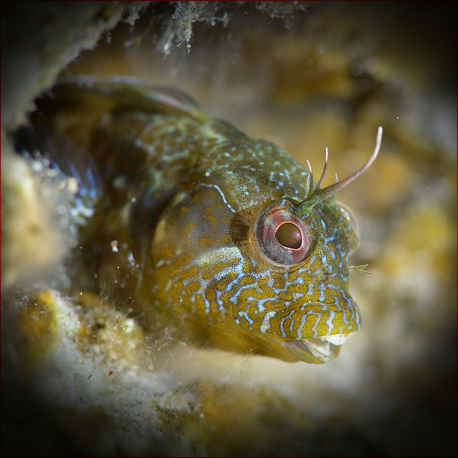More info
Datasheet
| Minimum Tank Size | 300 litres / 79.25 US gallons |
| Maximum Size | 6.0cm / 2.36inches |
| Reef Compatible | Often reef safe |
| Temperament | Might be aggressive towards other species |
| Temperature | 22.2°C / 71.96°F - 25.6°C / 78.08°F |
| Specific Gravity | 1.020-1.025 |
| Carbonate Hardness | 8-12 |
| pH | 8.1-8.4 |
General Description
The Mystery Blenny, scientifically known as Parablennius incognitus, belongs to the Blenniidae family. Typically found in the West Indian Ocean and Mediterranean Sea, these blennies have an oblong shape, a long dorsal fin, and small "legs" that aid in their movement on the substrate. They are relatively small, reaching a maximum size of about 6.0cm, and are not particularly vibrant in coloration.
Aquarium Suitability
Considered suitable for aquariums with care, Mystery Blennies prefer to thrive on their own without other members of the same species present. They have an average hardiness level and are often reef-safe, but may exhibit aggressive behavior towards other species sharing the tank.
Demands, Care, and Hardiness
Mystery Blennies are known to be herbivores, feeding primarily on algae from rocks and glass. While some individuals can be trained to accept dry foods, a sufficient algae growth in the tank is crucial for their dietary needs. They are recommended to be fed microalgae like spirulina and have a preference for zooplankton such as Cyclops and pods.
Reef Suitability
These blennies are often considered reef-compatible, making them a potential addition to reef aquariums. However, their occasional aggressive behavior towards other tank mates should be taken into consideration when adding them to a reef setup.
Aquarium Setup
For housing Mystery Blennies, a minimum tank size of 300 liters is recommended. Maintaining water conditions with a pH range of 8.1-8.4, a carbonate hardness (KH) of 8-12, a specific gravity (SG) of 1.020-1.025, and a temperature between 22.2-25.6°C is essential for their well-being.
Behaviour
These blennies are known to have an engaging personality, which can make them popular among aquarists. Their preference for solitude and tendency to graze on algae surfaces contribute to their unique behavior within aquarium settings.
Feeding and Diet
As herbivores, Mystery Blennies primarily feed on algae, with microalgae like spirulina being a recommended staple in their diet. Occasionally, they may consume zooplankton offerings such as Cyclops and pods for added nutritional variety.
Habitat and Distribution
In their natural habitat, Mystery Blennies are typically found in the West Indian Ocean and the Mediterranean Sea. They dwell among rock structures and algae-covered surfaces, utilizing their unique feeding behavior to sustain themselves within these marine environments.

